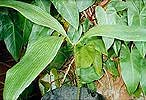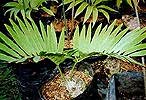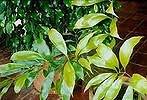 The Zamias and Chiguas of Colombia
The Zamias and Chiguas of Colombia
The author takes us on a comprehensive tour of
the cycads of his fabulous country which has such an overwhelmingly
rich flora, but is so dangerous to travel.
By Alvaro Calonje Daly, Pance, Cali, Colombia
Chamaerops No.41, Winter Edition 2001
[an error occurred while processing the directive]







1. Zamia wallisii: Plant displaying paddle-shaped mature leaves.
It is very rare to find plants with more than one leaf. Stem is
subterranean.
2. Zamia encephalartoides: Plant shows a roundish caudex with smooth
petioles and entire leaflets. Very striking plant.
3. Zamia manicata: Notice the collar in the base of the leaflet.
Leaflets are tough, shiny, and have a few spines in the upper third
portion.
4. Zamia obliqua: Plants with shiny apple green leaves that are
very tough. The sharp teeth occur in the upper third portion.
5. Zamia roezlii: Emerging leaves in this beautiful species are
bronze. The leaflets are curved, resembling the flexed wings of
a seagull. This is the biggest of all Zamia.
6. Zamia chigua: Notice the leaves emerging simultaneously. Leaflets
are closely spaced and very linear. Great plant for indoors.
7. Zamia amplifolia: Newly emerging leaves in this very rare Zamia.
Colombia is best known as the producer of the world‘s
finest coffee, but it is also infamous for cocaine and heroin production,
and the violent warfare these have helped engender. The violence
and widespread corruption that have plagued Colombia for over 30
years has mainly been the result of conflicts of interest among
drug dealers, weapons merchants, rich landowners, rebel Marxist
guerrillas, paramilitary groups, and the Colombian government.
It is hard to believe that such ugly conflict could
be staged in such an incredibly beautiful and biologically diverse
country. Colombia enjoys both Atlantic and Pacific Ocean coastlines,
and the Amazon jungle covers one-third of the country. In addition
to this, the Andes Mountain Range splits into three distinct ranges
in southern Colombia, thus giving the country wide valleys with
big rivers, and allowing for many different ecosystems which house
an astonishing biological diversity. With over 55,000, Colombia
contains 10% of the world‘s plant species, second only to the
much larger country of Brazil.
Ten percent of Colombia‘s landmass is part
of the National Park System, and some of these parks are occupied
by guerrilla units or paramilitary groups, thus impeding access
to these areas and the opportunity for research. This has contributed
to the mystery surrounding the Colombian Zamias.
Colombia has about 18 species of Zamias and Chiguas
occurring in different habitats that range from tropical rainforest
to high elevation cloud forest. Colombian Zamias are somewhat mythical
because some species were discovered last century by Wallis and
Braun and only rediscovered by Bernal, Restrepo, and Stevenson this
century. Some species have hardly ever been seen, others occur only
in small areas that are difficult and dangerous to access, while
others grew in areas that have been flooded for the construction
of large hydroelectric projects.
The different habitats where Zamias and Chiguas
occur are savanna in the Northern coast, which has well-defined
rainy and dry seasons; rainforest in both the Amazon and the Choco
areas; high tropical dry forest in the east of the country; and
cloud forest formation in the northwest.
The cloud forests of Antioquia contain two of the
worlds rarest and most endangered Zamia species, Zamia montana and
Zamia wallisii. Zamia montana is the highest elevation cycad in
the world, found at 2700m above sea level, and Z. wallisii is the
one with the largest leaflets. Both are endangered because of heavy
logging in the area. The Urrao cloud forest, one of the most beautiful
cloud forests in the world, has been decimated. Many of the prime
cloud forests of Colombia have been cut for poppy growing for the
manufacturing of heroin.
The highly elevated, tropical, dry forest of Santander
contains one species of rare beauty. Zamia encephalartoides is a
trunked Zamia that grows to six meters tall, has a black female
cone, and thrives in dry areas of two distinct localities in the
Chicamocha canyon. These plants are very resistant to salts and
drought. They do not like wet tropical conditions. I have seen them
growing outdoors in Southern California.
The savannas of Cordoba in Northern Colombia house
Chigua bernalii and Chigua restrepoi, two species of a newly described
genus that are truly exquisite in their architecture. Their leaflets
have a protruding midrib vein. These species are found growing together
and further studies may confirm that they are only one species.
Zamia muricata, which also grows in scrubland, is a smallish Zamia
with sharp teeth in its leaflets. Zamia ulei is found in the eastern
savanna of Colombia as both an understory and a full sun plant.
The Amazon and Choco rainforests hold a bounty of
different species of Zamia. Zamia amazonica occurs in both areas
in disjunct populations. Zamia roezlii is common, while others,
such as Zamia disodon, are extremely rare and possibly extinct.
It reportedly occurs in Peru as well. Zamias lived in America before
the uplifting of the Andes, and when this happened, many populations
were destroyed, allowing for disjunct populations to occur. You
see many cases of populations in the Amazon basin and the Choco
rainforest, separated by the Andes.
Zamia roezlii, which grows to a height of 10 meters,
is the largest of all the Zamias and is found near mangrove swamps
in the Pacific coast; it tolerates high salts and is quite a beautiful
Zamia, with high phenotypic variability. In the Calima Valley near
Buenaventura, one can find Zamia chigua, Zamia roezlii, and Zamia
amplifolia, amplifolia being more elusive and rare. Zamia chigua
is a rather peculiar-looking Zamia, with very fine, closely spaced
leaflets. I believe that these three species possibly produce natural
hybrids because of the different forms found. Mr. Whitelock has
studied the Zamias of the Calima Valley extensively and he reports
a high degree of phenotypic variations.
In the Choco, one can find Zamia manicata, which
has beautiful bronze emerging leaves and is one of two species of
Zamias with collars in their leaflets. The other, Zamia macrochiera,
is newly found. Zamia manicata makes a wonderful indoor plant. It
is a very tough plant and reportedly very common in some areas of
the Choco and maybe into the Darien in Panama.
Another species is Zamia obliqua, a tall Zamia that
can grow to eight meters and is found as an understory plant. It
has very nice apple-green leaflets and can have up to eight leaves
at a time. This species occurs also in Panama.
Zamia amazonica is one of the most attractive Zamias,
with its gorgeous red emerging flushes and deep, dark, glossy leaves.
This one has great horticultural potential because of its beauty.
This is a very tough and worthy plant. There are also several smaller
Zamias in the Choco and the Amazon and they are Z poeppigiana, Z
melanorachis and Z lecontei.
The state of conservation of Zamias in Colombia shows some promise
by the work of the botanical garden in Medellin and a private arboretum
near Cali. Unfortunately, the Pacific rainforest has been targeted
as a prime coca leaf growing area, and it is being logged and planted
now. The rainforest of Colombia have traditionally been places where
people have always come to take something, never to leave anything,
be it gold, platinum, hardwoods, or Zamias. It seems so durable
and resilient, and yet it is very frail. Hopefully the conflict
affecting Colombia will deescalate to negotiations and botanists
from all over the world will be able to visit this beautiful and
diverse country.

Readers Comments:
(No comments yet. Be the first to add a comment to
this article!)
|
 |
[an error occurred while processing the directive] |
